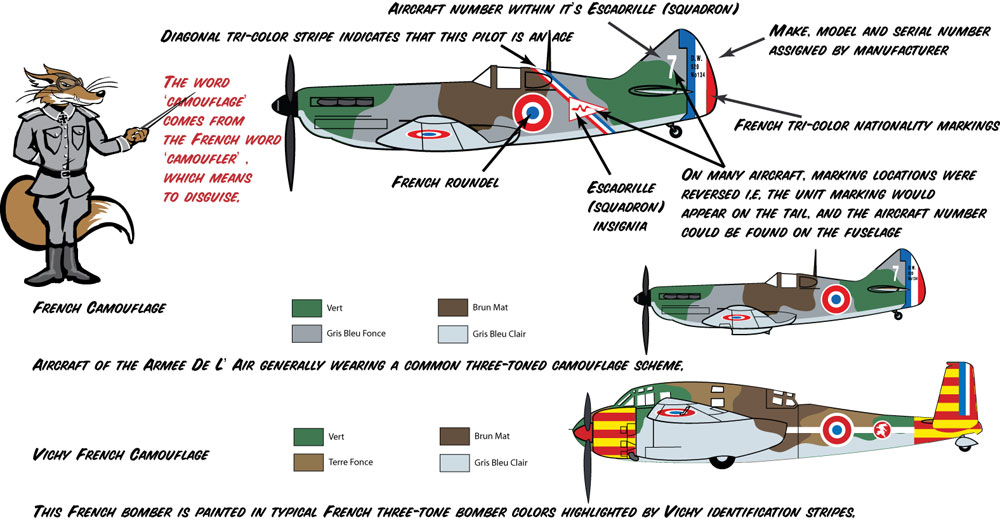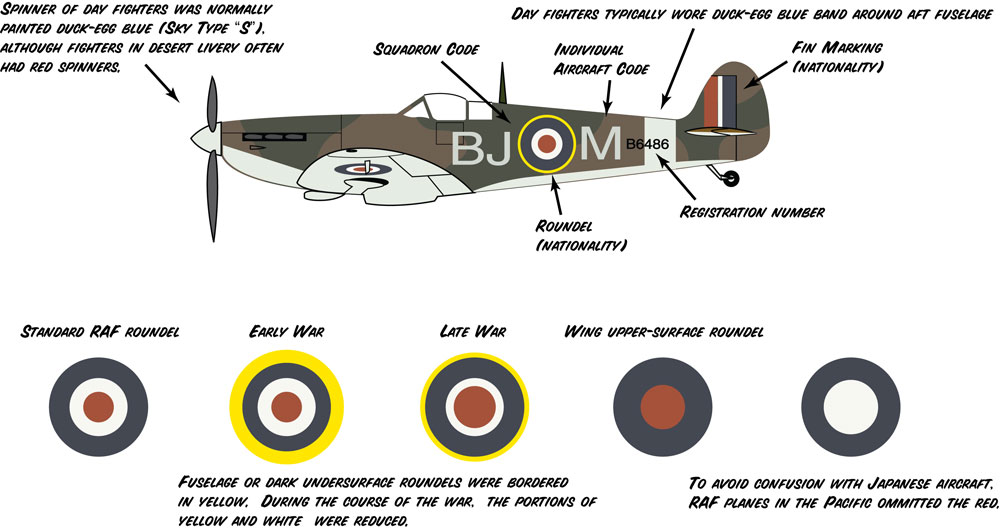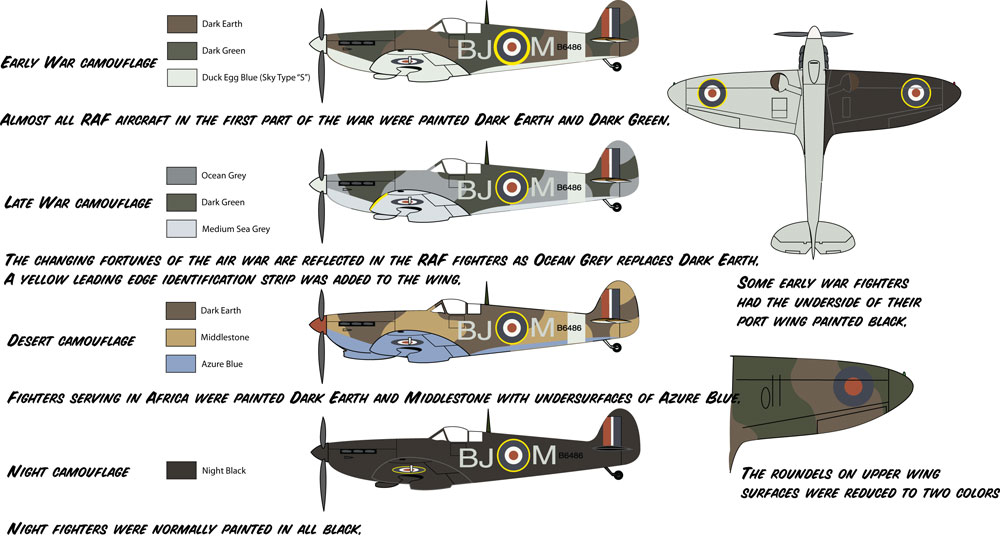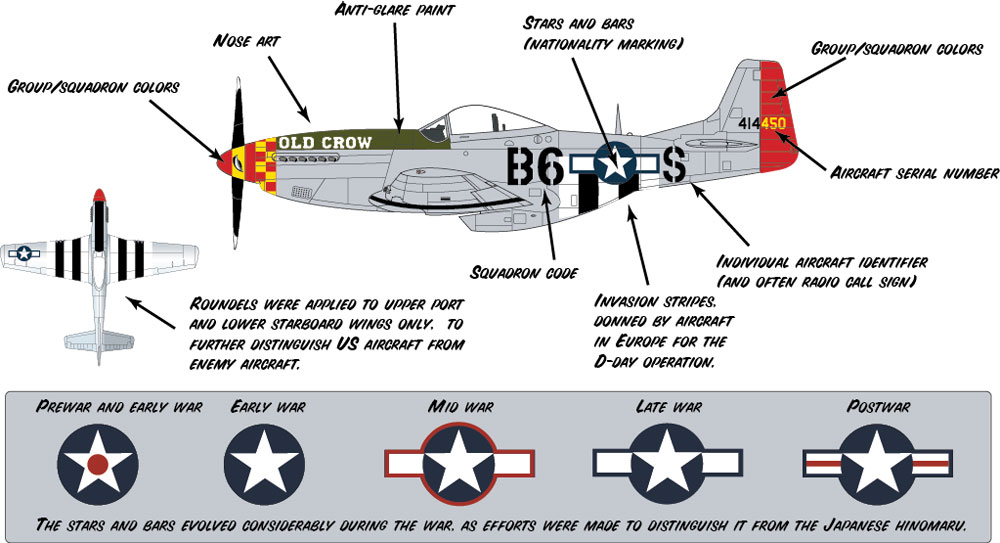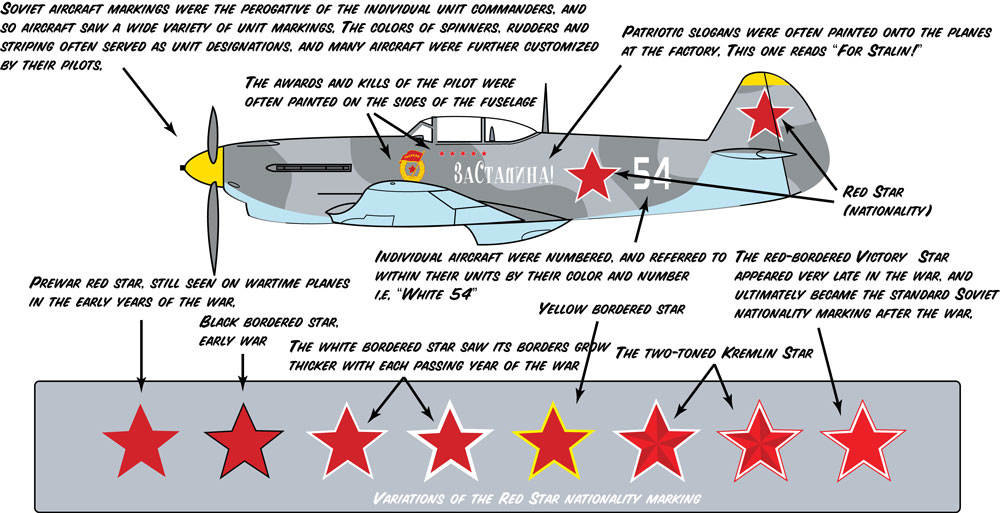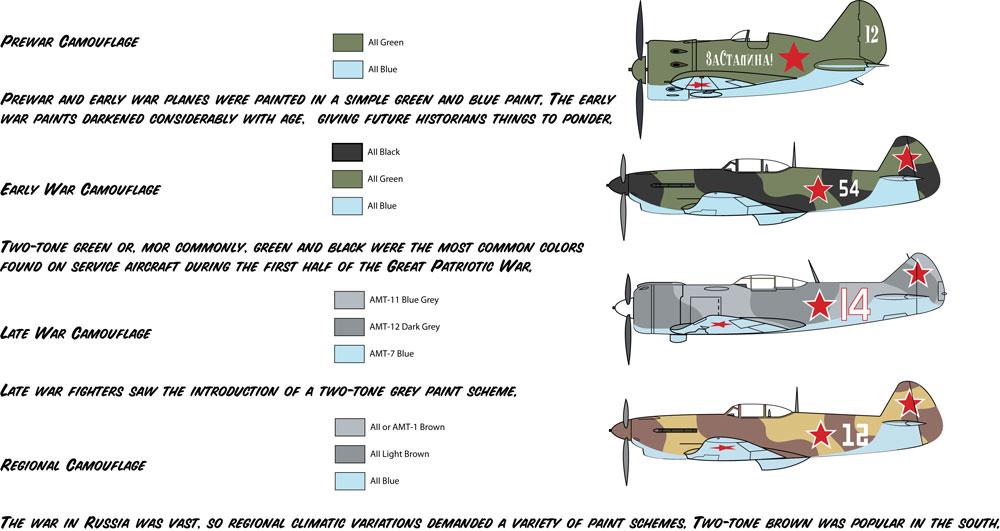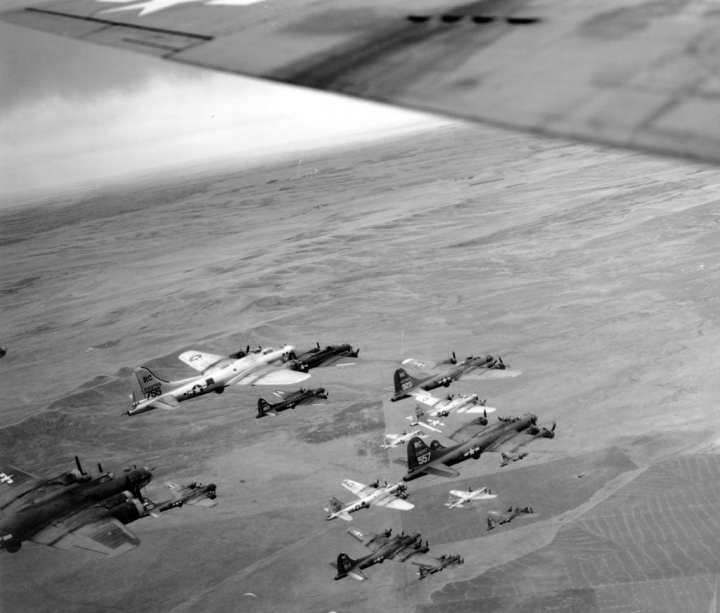Mugwop
SENIOR MEMBER

- Joined
- May 29, 2013
- Messages
- 6,730
- Reaction score
- 2
- Country
- Location
Reasons to Paint a Plane for Combat
The history of World War II aircraft paint colors and camouflage in military aircraft is a fascinating study. Volumes have been filled on all the different variations of paint that were used on military aircraft. In World War I it was the practice to fire on all aircraft at a distance because nobody could tell whether it was an enemy or friend, as recognizing the British Royal Air Force (RAF) roundel or a German (Luftwaffe) Iron Cross in the air was far from easy. But in WW2 it was a completely different story. The planes now were "identifiable" through distinctive colors used by the various air forces. Camouflage had also been introduced, giving pilots an advantage in dogfights depending on their particular location in the fight.
Which Colors for Camouflage?
Aircraft camouflage is the use of light and dark colors to make the aircraft difficult to see. Military planes flying at night would use flat black or dark green on the underside of the plane and sometimes on the whole plane to help hide the vehicle at night. All camouflage colors are flat to refract the least amount of light. However, this flat paint would cause both skin friction and drag. This caused a reduction in speed when flying. So, while camouflage had its advantages for much of the war, it also caused occasional problems.
Nose and Wing Art
Nose art refers to an individualized design or painting in essence graffiti usually on the fuselage or nose of a military aircraft. This graffiti which was psychologically satisfying to the pilots is now referred to in some circles as a type of folk art. It was never officially approved which also led to its appeal. It was commonplace for pilots and aerial squads to paint foreboding images such as skulls and bones or sexy images like scantily-clad women. It worked as both a morale booster and a way to let off steam. The practice started in Italy and Germany and both Axis and Allied pilots and ground crew took part in this form of art. Nose art was not officially allowed on United States Navy planes and was uncommon on RAF aircraft.Art on the wings was primarily used for identification purposes. The French and British planes used different forms of circle roundels. The Germans used Iron Crosses. Japanese planes sported red dots, helping to promote the nickname "zero." Meanwhile, the USand Soviet Union used different forms of star emblems. Each of these were placed on various spots on the plane, most notably the wings. During a particularly intense dogfight with similar models of aircraft, a pilot would simply have to visually check the wing to see if another plane was an enemy or friend.
Soviet Red Air Force and Naval Aviation
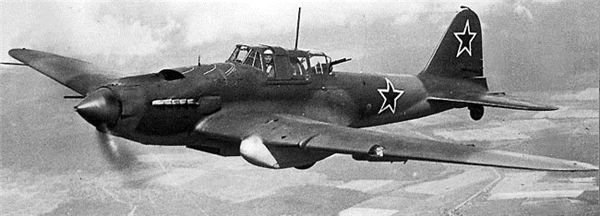
The People’s Commissariat for the Aviation Industry did issue color templates for the Soviet Air Force but the standard colors specified were not always followed. There were wide variations in colors of USSR aircraft. The specified colors included a brilliant medium blue for the undersides. For the main body of the planes a variety of greens were used including olive green, forest green, and dark green in conjunction with black, light and dark browns and grays. By the end of the war, most Soviet planes were painted with the simple red star roundels.
French Army of the Air
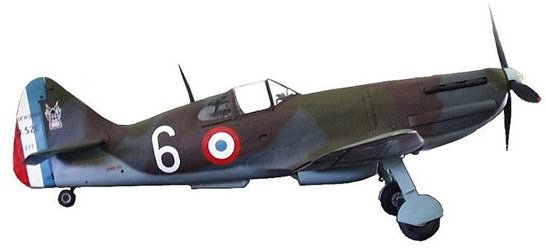
During World War II the French or Armee de L’Air did very little flying, as they were quickly overtaken by the German Blitzkrieg. Few French aircraft evacuated to the United Kingdom or were stationed in Allied zones. However, many of these were recommissioned into British hands and colors. Notably, the French were the first to use roundels on a combat aircraft. They used the tricolor cockade with the blue, white and red of their flag.
British Royal Air Force

The British aircraft in WW2 sported sky colors on the underside of the planes, and ocean gray or sea gray on the top. This provided a pattern that was well suited to higher altitudes. Slight modifications to the colors were made for aircraft which flew over water. For water attacks the aircraft were painted extra dark sea gray or dark slate gray. Night bombers used black or ‘special night’ in coloration for the underbelly and dark brown and green for the fuselage and wings. The camouflage on British aircraft changed throughout the war depending on where the planes were flying. Some planes were even painted pink since they were flown at dawn or sunset. The RAF also used roundels on their military aircraft which changed several times during the war.The right paint color to give a plane the perfect camouflage was extremely important in WW2. All of the nations tried something different to get it right: the German Luftwaffe, the Imperial Japanese Navy, the US Army Air Force, the Soviet Red Air Force, the Italian Air Force, the French Air Force and the Royal Air Force.
United States Army Air Force and Navy
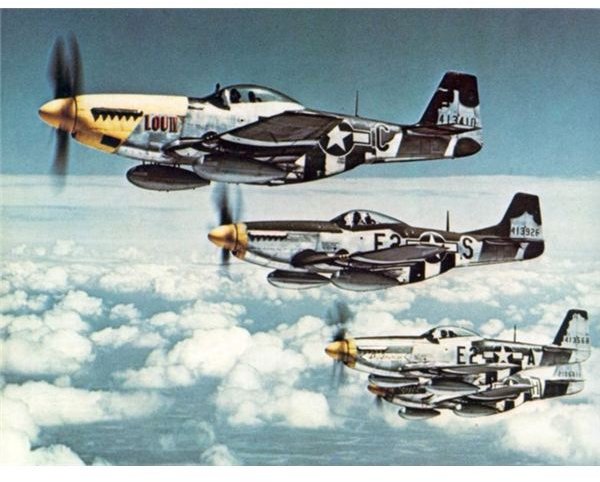
The United States had strict standards in place for the colors of camouflage on military aircraft, although these standards did change over the years. The Army Air Force used mostly an olive drab paint above and neutral gray on the undersides. Blue or gray was also widely used on the bottom of aircraft so that the planes blended with the sky when looking up at them. The Navy aircraft, on the other hand, used a bluish gray on top with a brownish gray below. Special operations called for special colors that would distinguish them from other forces. An example of such is the invasion stripes used on planes during the Normandy invasion. These invasion stripes were painted in order for quick visual identification by friendly forces. They were later removed as the war continued.In the later stages of World War II the US nearly did away with camouflage altogether. Radar was used to find aircraft and so planes were left unpainted with bare metal finishes. This helped with flying as it reduced friction and weight. The US Army Air Force pilots were famous for the ‘nose art’ painted on their military aircraft. Fighter units added their own unit color markings to their planes such as colored spinners and nose band designs. Many pilots viewed this as a way to intimidate the enemy. US military aircraft also added the famous Stars and Bars insignia to the roundels on their planes.
German Luftwaffe

The standard colors for German planes were strictly prescribed by the German State Ministry for Aviation. In the latter part of the Second World War when items like paint became scarce, plane colors were a little more varied. In general, the undersides of German aircraft were light blue or light gray. The fuselage and wings were generally dark green through 1940 and then were switched to a two-tone gray until the end of the war. In the later part of the war the Luftwaffe added yellow Home Defense markings to the planes. German aircraft were also sometimes sprayed with white paint for winter camouflage. Slight differences in camouflage colors were determined for different types of military aircraft including fighters, destroyers, bombers, transports, naval aircraft and tropical aircraft. The insignia for German airplanes was the black cross on a white background called the Balkenkreuz and was widely known as the Iron Cross.
Imperial Japanese Army Air Service
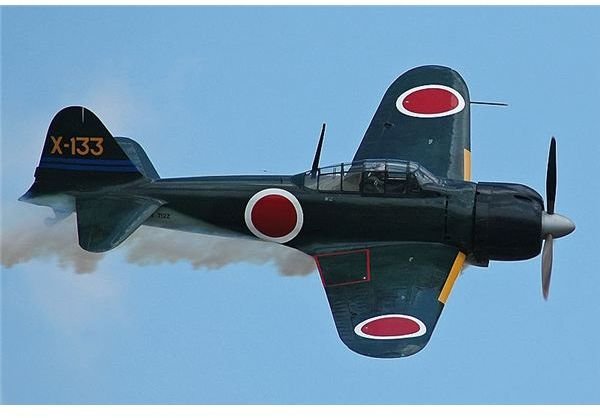
The Japanese used camouflage in grays, dark green and pale blue gray on the undersides. The paint used on most Japanese military aircraft in World War II did not adhere well so camouflage was always a problem. Some planes were left in the natural metal and left to weatherize to a pale gray. Almost all Japanese military planes had a narrow white strip as a ‘field identification mark’ which went around the Hinomaru the red circle which made up the Japanese national insignia. Generally there were also yellow or orange strips on the edges of the wings.
Italian Aeronautic Military

Italy’s aircraft during World War II was probably the most colorful of all the combat planes. The colors were determined at the factory instead of by the military. This meant that the colors changed depending on the location of the actual building site. Due to the size of Mussolini’s empire, comprised of the various Italian states and other dominated territories, the paint colors ranged in nearly every conceivable way. These colors also changed during the war. The early camouflage colors were verde mimetico, galo mimetico, marrone mimetico, and grigio chiaro. The colors were applied in broad stripes not traditional camouflage. Later in the war, circa 1941, the Italian air force ‘Regia Aeronautica’ standardized their paint colors into a more traditional camouflage of a two tone green and brown. At the same time, the underbellies of most of the planes were painted gray.
Paint Continues to Play a Military Role
As it was already mentioned, airplanes played a major role in WW2. In fact, relying on stron air power is a doctrine used by several militaries to this day. Of course, with the invention of radar and the development of radar invisibility, the colors started to play a lesser role, but the tradition is still here. Nowadays, insignia is still used by nations to delineate planes. Even unmanned aerial vehicles are painted with distinctive colors and use camouflage to hide in the sky.
WW2 spy planes pink camouflage

They were painted pink because of the visible light that we see as blue down on the ground is actually filtered out and reflected, casting objects in the sky (like clouds) with a pinkish hue. These Spitfires flew missions at dawn and dusk, where they blended perfectly with cloud cover.Spitfires went through extensive rounds of camouflage paint, from dark and light brown, to a pale gray, to a baby blue. Perhaps their most unusual color, though, was a light pink. the planes were ideally meant to fly at sunset and sunrise, when the clouds took on a pinkish hue and made the plane completely invisible against them, they were also useful during the day. Clouds are pinker than we give them credit for. We perceive them as white against the sky because the particles in the sky scatter blue light, sending some of it down towards us and letting us see the sky as blue. Clouds scatter every kind of light, and against the intense blue sky look whitish gray. But their color depends on what kind of light gets to them, and what they are floating next to.In the evenings, when the sky was pink with the sunset, they were far more invisible than a white plane shining against a pastel cloud.
The history of World War II aircraft paint colors and camouflage in military aircraft is a fascinating study. Volumes have been filled on all the different variations of paint that were used on military aircraft. In World War I it was the practice to fire on all aircraft at a distance because nobody could tell whether it was an enemy or friend, as recognizing the British Royal Air Force (RAF) roundel or a German (Luftwaffe) Iron Cross in the air was far from easy. But in WW2 it was a completely different story. The planes now were "identifiable" through distinctive colors used by the various air forces. Camouflage had also been introduced, giving pilots an advantage in dogfights depending on their particular location in the fight.
Which Colors for Camouflage?
Aircraft camouflage is the use of light and dark colors to make the aircraft difficult to see. Military planes flying at night would use flat black or dark green on the underside of the plane and sometimes on the whole plane to help hide the vehicle at night. All camouflage colors are flat to refract the least amount of light. However, this flat paint would cause both skin friction and drag. This caused a reduction in speed when flying. So, while camouflage had its advantages for much of the war, it also caused occasional problems.
Nose and Wing Art
Nose art refers to an individualized design or painting in essence graffiti usually on the fuselage or nose of a military aircraft. This graffiti which was psychologically satisfying to the pilots is now referred to in some circles as a type of folk art. It was never officially approved which also led to its appeal. It was commonplace for pilots and aerial squads to paint foreboding images such as skulls and bones or sexy images like scantily-clad women. It worked as both a morale booster and a way to let off steam. The practice started in Italy and Germany and both Axis and Allied pilots and ground crew took part in this form of art. Nose art was not officially allowed on United States Navy planes and was uncommon on RAF aircraft.Art on the wings was primarily used for identification purposes. The French and British planes used different forms of circle roundels. The Germans used Iron Crosses. Japanese planes sported red dots, helping to promote the nickname "zero." Meanwhile, the USand Soviet Union used different forms of star emblems. Each of these were placed on various spots on the plane, most notably the wings. During a particularly intense dogfight with similar models of aircraft, a pilot would simply have to visually check the wing to see if another plane was an enemy or friend.
Soviet Red Air Force and Naval Aviation

The People’s Commissariat for the Aviation Industry did issue color templates for the Soviet Air Force but the standard colors specified were not always followed. There were wide variations in colors of USSR aircraft. The specified colors included a brilliant medium blue for the undersides. For the main body of the planes a variety of greens were used including olive green, forest green, and dark green in conjunction with black, light and dark browns and grays. By the end of the war, most Soviet planes were painted with the simple red star roundels.
French Army of the Air

During World War II the French or Armee de L’Air did very little flying, as they were quickly overtaken by the German Blitzkrieg. Few French aircraft evacuated to the United Kingdom or were stationed in Allied zones. However, many of these were recommissioned into British hands and colors. Notably, the French were the first to use roundels on a combat aircraft. They used the tricolor cockade with the blue, white and red of their flag.
British Royal Air Force

The British aircraft in WW2 sported sky colors on the underside of the planes, and ocean gray or sea gray on the top. This provided a pattern that was well suited to higher altitudes. Slight modifications to the colors were made for aircraft which flew over water. For water attacks the aircraft were painted extra dark sea gray or dark slate gray. Night bombers used black or ‘special night’ in coloration for the underbelly and dark brown and green for the fuselage and wings. The camouflage on British aircraft changed throughout the war depending on where the planes were flying. Some planes were even painted pink since they were flown at dawn or sunset. The RAF also used roundels on their military aircraft which changed several times during the war.The right paint color to give a plane the perfect camouflage was extremely important in WW2. All of the nations tried something different to get it right: the German Luftwaffe, the Imperial Japanese Navy, the US Army Air Force, the Soviet Red Air Force, the Italian Air Force, the French Air Force and the Royal Air Force.
United States Army Air Force and Navy

The United States had strict standards in place for the colors of camouflage on military aircraft, although these standards did change over the years. The Army Air Force used mostly an olive drab paint above and neutral gray on the undersides. Blue or gray was also widely used on the bottom of aircraft so that the planes blended with the sky when looking up at them. The Navy aircraft, on the other hand, used a bluish gray on top with a brownish gray below. Special operations called for special colors that would distinguish them from other forces. An example of such is the invasion stripes used on planes during the Normandy invasion. These invasion stripes were painted in order for quick visual identification by friendly forces. They were later removed as the war continued.In the later stages of World War II the US nearly did away with camouflage altogether. Radar was used to find aircraft and so planes were left unpainted with bare metal finishes. This helped with flying as it reduced friction and weight. The US Army Air Force pilots were famous for the ‘nose art’ painted on their military aircraft. Fighter units added their own unit color markings to their planes such as colored spinners and nose band designs. Many pilots viewed this as a way to intimidate the enemy. US military aircraft also added the famous Stars and Bars insignia to the roundels on their planes.
German Luftwaffe

The standard colors for German planes were strictly prescribed by the German State Ministry for Aviation. In the latter part of the Second World War when items like paint became scarce, plane colors were a little more varied. In general, the undersides of German aircraft were light blue or light gray. The fuselage and wings were generally dark green through 1940 and then were switched to a two-tone gray until the end of the war. In the later part of the war the Luftwaffe added yellow Home Defense markings to the planes. German aircraft were also sometimes sprayed with white paint for winter camouflage. Slight differences in camouflage colors were determined for different types of military aircraft including fighters, destroyers, bombers, transports, naval aircraft and tropical aircraft. The insignia for German airplanes was the black cross on a white background called the Balkenkreuz and was widely known as the Iron Cross.
Imperial Japanese Army Air Service

The Japanese used camouflage in grays, dark green and pale blue gray on the undersides. The paint used on most Japanese military aircraft in World War II did not adhere well so camouflage was always a problem. Some planes were left in the natural metal and left to weatherize to a pale gray. Almost all Japanese military planes had a narrow white strip as a ‘field identification mark’ which went around the Hinomaru the red circle which made up the Japanese national insignia. Generally there were also yellow or orange strips on the edges of the wings.
Italian Aeronautic Military

Italy’s aircraft during World War II was probably the most colorful of all the combat planes. The colors were determined at the factory instead of by the military. This meant that the colors changed depending on the location of the actual building site. Due to the size of Mussolini’s empire, comprised of the various Italian states and other dominated territories, the paint colors ranged in nearly every conceivable way. These colors also changed during the war. The early camouflage colors were verde mimetico, galo mimetico, marrone mimetico, and grigio chiaro. The colors were applied in broad stripes not traditional camouflage. Later in the war, circa 1941, the Italian air force ‘Regia Aeronautica’ standardized their paint colors into a more traditional camouflage of a two tone green and brown. At the same time, the underbellies of most of the planes were painted gray.
Paint Continues to Play a Military Role
As it was already mentioned, airplanes played a major role in WW2. In fact, relying on stron air power is a doctrine used by several militaries to this day. Of course, with the invention of radar and the development of radar invisibility, the colors started to play a lesser role, but the tradition is still here. Nowadays, insignia is still used by nations to delineate planes. Even unmanned aerial vehicles are painted with distinctive colors and use camouflage to hide in the sky.
WW2 spy planes pink camouflage

They were painted pink because of the visible light that we see as blue down on the ground is actually filtered out and reflected, casting objects in the sky (like clouds) with a pinkish hue. These Spitfires flew missions at dawn and dusk, where they blended perfectly with cloud cover.Spitfires went through extensive rounds of camouflage paint, from dark and light brown, to a pale gray, to a baby blue. Perhaps their most unusual color, though, was a light pink. the planes were ideally meant to fly at sunset and sunrise, when the clouds took on a pinkish hue and made the plane completely invisible against them, they were also useful during the day. Clouds are pinker than we give them credit for. We perceive them as white against the sky because the particles in the sky scatter blue light, sending some of it down towards us and letting us see the sky as blue. Clouds scatter every kind of light, and against the intense blue sky look whitish gray. But their color depends on what kind of light gets to them, and what they are floating next to.In the evenings, when the sky was pink with the sunset, they were far more invisible than a white plane shining against a pastel cloud.








